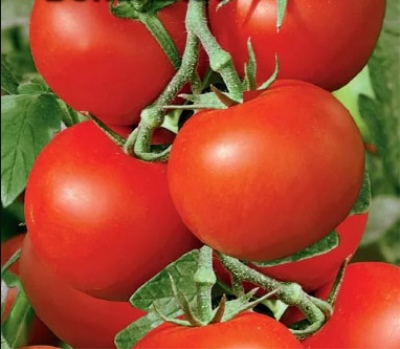
- Authors: Dubinin S.V., Kirillov M.I., LLC "Agrofirm" SeDeK "
- Year of approval: 2004
- Category: grade
- Growth type: determinant
- Appointment: fresh consumption, for juice, for ketchup and tomato paste
- Ripening period: ultra early
- Ripening time, days: up to 95
- Growing conditions: for open ground
- Marketability: high
- Marketable fruit yield,%: up to 99%
In the 2000s, Russian breeders created a range of attractive crops. They can be just as effective in the garden as newer fruit plants. And one of these options is just a tomato Flash.
Breeding history
This variety was created on the site of the Sedek agricultural company. The main varietal work was coordinated by S. V. Dubinin and M. I. Kirillov. Official admission to use took place in 2004. From that moment on, the Flash became available to most domestic gardeners.
Description of the variety
It is one of the determinant plants. You can only cultivate such a tomato outdoors. The size of the bush does not exceed 0.4-0.5 m. Moderately large foliage is painted in a dark green tone. It should also be noted that this is an excellent standard variety.
The main qualities of the fruit
Light green color is typical for unripe Flash berries. Gaining consumer condition, they will blush. The mass of a single tomato is usually from 80-110 g. Rounded fruits cannot boast of pronounced ribbing. They will develop on complex inflorescences with articulated stalks.
Taste characteristics
Consumers note the excellent taste of these tomatoes. In addition to the attractive gastronomic qualities, it is worth emphasizing the abundance of vitamins and lycopene. Consume the harvest:
fresh;
for processing into juice;
for ketchup or tomato paste.
Ripening and fruiting
An attractive feature of the Flash is its ultra-early character. You can wait for the first harvest already in a maximum of 95 days after the greens are pecked. Culture will ripen amicably and cheerfully.
Yield
The number of fruits will be quite large. But this is a relative indicator - only in comparison with other tomatoes designed for harsh growing conditions. For obvious reasons, it will not work to compete with the most advanced varieties. Harvesting with competent agricultural technology can reach 4.8 kg per 1 sq. m or 2.5 kg per plant. The share of the marketable crop is 99%.
The timing of planting seedlings and planting in the ground
The dates of sowing seeds in containers should be chosen as scrupulously as possible. It is possible to transplant seedlings to a permanent place only after 50-55 days. It will take another 5-7 days for the seeds to hatch and give confident shoots. It is also useful to provide 4-5 days for adaptation after a dive. Usually, seedlings start in late March or early April, and transplants into open land occur in late May or early June.

Growing tomato seedlings is an extremely important process, because it largely depends on whether the gardener can harvest at all. All aspects must be taken into account, from seedbed preparation to planting in the ground.
Landing scheme
It is usually recommended to adhere to the 400x600 mm rule. Any other setups are inappropriate.

Growing and caring
Complex agricultural activities are not required. Consistent results are achieved even with relatively modest efforts. You don't have to tie the bushes to the support. In the last 10 days before planting, the seedlings must be accustomed to severe weather tests. Top dressing is carried out every 3 weeks during the growing season.
The choice of fertilizer is determined by the condition of the plants. The stepsons are removed as needed. The inoculum is pre-treated with Agat or Kornevin preparations. Seedlings often require phytolamp lighting. Pots picking is done after 2 true leaves emerge.




A plant needs different micronutrients at each stage of growth. All fertilizers can be divided into two groups: mineral and organic. Folk remedies are often used: iodine, yeast, bird droppings, eggshells.
It is important to observe the rate and period of feeding. This also applies to folk remedies and organic fertilizers.
Disease and pest resistance
Such a formidable opponent for a plant breeder, like late blight, infects the Outbreak bushes rather weakly. But it is still necessary to defend against it. The danger can be represented by a black leg, fusarium wilting. Some plants suffer from rot, mottling and stolbur. The flash can be eaten by:
wireworms;
whitefly;
bear;
spider mite;
sprout fly;
slug;
aphid;
Colorado beetle.


Resistant to adverse weather conditions
In a bad meteorological situation, such a tomato feels pretty good. However, miracles do not happen - in such a situation, one cannot count on large harvests.The plant can be useful for seedless cultivation even in areas of unsustainable farming.
Growing regions
The flash is recommended for:
Siberian;
central black earth;
Ural;
Far Eastern;
Volga region;
North Caucasian;
Volga-Vyatka farms.
Review overview
Gardeners note:
full resistance to harsh conditions;
the relevance of competent agricultural technology;
the nutritional value of the crop;
the opportunity to feast on tomatoes quite early, even if it is a cold summer;
the ability to breed a plant with seeds extracted from berries.

























































































